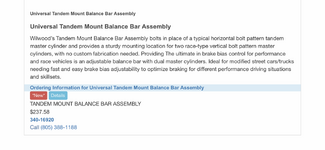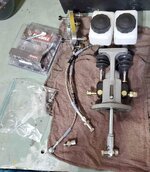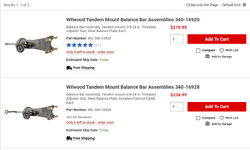You are using an out of date browser. It may not display this or other websites correctly.
You should upgrade or use an alternative browser.
You should upgrade or use an alternative browser.
Wilwood adapter
- Thread starter rtj
- Start date
Is that $237 from Wilwood? If so, that a good deal and a nice piece.
rtj
Well-known member
- Joined
- Nov 5, 2011
- Messages
- 3,153
Yeah, the alum body, pivot, and push rod.
Cheaper at summit. Picture is accurate here:

 www.summitracing.com
www.summitracing.com
Cheaper at summit. Picture is accurate here:

Wilwood Disc Brakes 340-16920 Wilwood Tandem Mount Balance Bar Assemblies | Summit Racing
Free Shipping - Wilwood Tandem Mount Balance Bar Assemblies with qualifying orders of $109. Shop Pedal Assembly Balance Bars at Summit Racing.
rtj
Well-known member
- Joined
- Nov 5, 2011
- Messages
- 3,153
Yes. The facebook marketplace photo at the top was $500. It sold very fast. It had an extra aluminum adapter for a particular car.
I was curious as I like this idea. Summit sells a $370 kit. Getting the right bore size is key. Years ago I bought some, I think 1" bore was recommended for a c3. But you know what they say about free advice….
Wilwood Master Cylinders and Tandem Mount Balance Bar Kits S0002[

 www.summitracing.com
www.summitracing.com
I was curious as I like this idea. Summit sells a $370 kit. Getting the right bore size is key. Years ago I bought some, I think 1" bore was recommended for a c3. But you know what they say about free advice….
Wilwood Master Cylinders and Tandem Mount Balance Bar Kits S0002[

Wilwood Disc Brakes S0002 Wilwood Master Cylinders and Tandem Mount Balance Bar Kits | Summit Racing
Free Shipping - Wilwood Master Cylinders and Tandem Mount Balance Bar Kits with qualifying orders of $109. Shop Master Cylinders at Summit Racing.
Last edited:
rtj
Well-known member
- Joined
- Nov 5, 2011
- Messages
- 3,153
Wilwood offers a compact aluminum master cylinder specifically engineered for the manual brakes on C2 Corvettes. Not only is this an all-new, lightweight unit, but the bore is sized to make the brakes more effective with less pedal effort. Part number 260-16521, with a 15/16" bore, improves line pressure by more than 10% for a given amount of pedal force compared to the stock 1" bore. For a further reduction in pedal effort or increase in caliper clamping force, part number 260-16520 has a 7/8" bore.
Below from VanSteel
"C2/C3 Wilwood Master Cylinders
The hydraulic side of the brake system is based on leverage ratios. The overall system leverage ratio is a function of:
1. Brake pedal ratio
2. Master cylinder bore size
3. Effective caliper piston area
An OE manual brake C2 or C3 by my comparison formula has a 36:1 front circuit leverage ratio. The rear circuit is a little over 19:1. When you compare those two leverage ratios front to rear, that gives you your static front to rear bias ratio which in this case is 65/35.
If you use the 1.125″ MC on a manual brake D8 caliper car, instead of the normal 1″, your front leverage drops to 28.5:1. When you drop to the piston area of his SL6 calipers, and using the 1.125″ power brake master cylinder, your front leverage ratio drops to 21:1, representing a 39% loss in brake leverage from OE D8. That translates to requiring 39% more leg effort to get comparable clamping force.
So yes, it will make a measurable difference.
And for an FYI, the current version of the SL6 using 1.75/1.25/1.25 pistons with a 15/16″ bore master cylinder give a front circuit leverage ratio of 36.19:1 which is a hair higher than OE D8 manual, but probably not enough to feel a difference.
If you install the 7/8″ master cylinder, this will restore the front leverage ratio to 34.7:1, or almost back to to OE D8 effort levels. The pedal will be slightly firmer than an OE D8 manual brake car, but will now be able to make 39% more pressure with the same amount of pedal effort."
Below from VanSteel
"C2/C3 Wilwood Master Cylinders
The hydraulic side of the brake system is based on leverage ratios. The overall system leverage ratio is a function of:
1. Brake pedal ratio
2. Master cylinder bore size
3. Effective caliper piston area
An OE manual brake C2 or C3 by my comparison formula has a 36:1 front circuit leverage ratio. The rear circuit is a little over 19:1. When you compare those two leverage ratios front to rear, that gives you your static front to rear bias ratio which in this case is 65/35.
If you use the 1.125″ MC on a manual brake D8 caliper car, instead of the normal 1″, your front leverage drops to 28.5:1. When you drop to the piston area of his SL6 calipers, and using the 1.125″ power brake master cylinder, your front leverage ratio drops to 21:1, representing a 39% loss in brake leverage from OE D8. That translates to requiring 39% more leg effort to get comparable clamping force.
So yes, it will make a measurable difference.
And for an FYI, the current version of the SL6 using 1.75/1.25/1.25 pistons with a 15/16″ bore master cylinder give a front circuit leverage ratio of 36.19:1 which is a hair higher than OE D8 manual, but probably not enough to feel a difference.
If you install the 7/8″ master cylinder, this will restore the front leverage ratio to 34.7:1, or almost back to to OE D8 effort levels. The pedal will be slightly firmer than an OE D8 manual brake car, but will now be able to make 39% more pressure with the same amount of pedal effort."
Last edited:
phantomjock
Well-known member
I'll shout out to HP Academy.
These Kiwis have a wealth of information on YT as well as their web site.
They were running a 50% off special on some of their classes at Christmas - and I almost went for it.
Quality was good - just figured I had too much time at the PC already - and not enough in the garage.
There are a bunch of white papers (under "tech"as I recall) you can download too.
Good find.
Cheers - Jim
These Kiwis have a wealth of information on YT as well as their web site.
They were running a 50% off special on some of their classes at Christmas - and I almost went for it.
Quality was good - just figured I had too much time at the PC already - and not enough in the garage.
There are a bunch of white papers (under "tech"as I recall) you can download too.
Good find.
Cheers - Jim
SuperBuickGuy
Well-known member
I'm about done with Wilwood - their quality is so hit and miss anymore. I like Tilton for now....
Latest posts
-
-
Transverse rear spring rate adjustment ponderings.
- Latest: phantomjock
-



